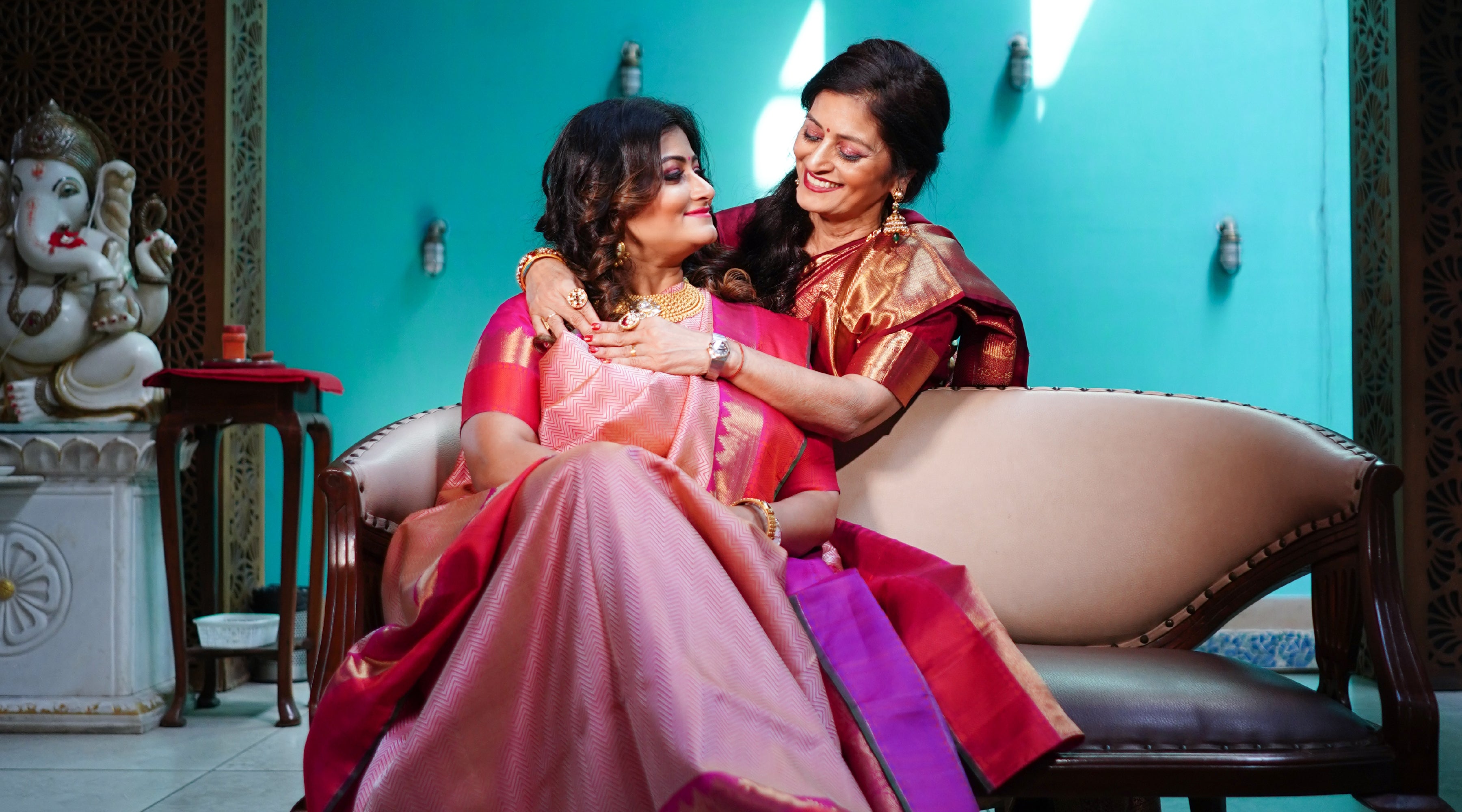KANAKAVALLI VIGNETTES : Saritha Padmanabhan - Life By Design

Kanakavalli’s June Vignette, Saritha Padmanabhan, is an interior designer and a collector of all things beautiful. Saritha spent over two decades working with various multinational corporations, facing numerous challenges as a woman in a male-dominated industry, but also imbibing lessons that continue to serve her at work and in life. In conversation with Aneesha Bangera for The Kanakavalli Blog, Saritha reminisces about growing up in a family that loved art and culture on the one hand, and sport on the other, and how she effortlessly learnt to appreciate both. Her collection of art and antiques consists of objects inherited, found and bought, while she loves to work with clients to find pieces that match their tastes and spaces. For Saritha, the sari is the epitome of both power and elegance, and the kanjivaram is close to her heart. Browsing through the Kanakavalli repertoire between work projects, Saritha curates a selection of saris that reflect her love for beauty and tradition. Excerpts of the conversation below…
Life by Design
Tell us a little about your childhood, and what it was like growing up in a family that loved tradition, art and music.
My maternal grandparents were from Mysore, and my mother grew up as one of five sisters. They were all inclined towards the arts, each playing a different musical instrument. Every day a different teacher would come to the house for lessons—in the veena, the banjo, the violin. My grandmother was a singer and would sometimes perform on the radio. One of my aunts was an artist who painted beautifully. I grew up in Bangalore, but as children, my siblings and I spent every vacation in Mysore, which was just a short distance away. Thus, we spent a great deal of time in this environment of art and culture. In Mysore, we were part of a big joint family, where tradition was the most important thing.
On my father’s side, sport was what brought the family together. My father and his elder brother were footballers who played for the country. So, while on the one hand I was trained in classical music, on the other I played football for the State’s under-16 team. I then switched to playing basketball, and I played for the university as well as the State juniors while I was in college.
Growing up, I was the only girl surrounded by brothers, and I ended up getting married very young. But I truly believe that I had the best of both worlds—effortlessly learning to appreciate both art and culture as well as sports.

Above (clockwise from left): Tradition was an important aspect of Saritha's childhood; A childhood portrait; Saritha, several years ago.
What was your experience as a woman working in large multinational firms? What are some of the lessons you still carry with you today?
When I started working in construction as a project auditor, it was a very male-dominated industry. In every department I worked in, I would be the only woman. I remember finding it very difficult in the beginning, but I eventually started to enjoy my job. I faced a different challenge every day, and learnt so much from the experience. I worked hard and made no excuses—nothing was offered to me on a platter, but the lessons I learnt will stay with me forever. Much of my learning was done on the job, and I had to face some really tough bosses. I remember thinking that if I could survive working under them, I could work under anybody in the world!

I was fortunate to work on some exciting projects in my career. I was closely involved in a project designing gated communities for the Housing Board of Singapore. I was also part of the team that brought the first gated community to Hyderabad. I spent almost 10 years working in Malaysia and Singapore after which I decided to return to India. Fortunately, my husband and I worked in the same industry—he was in building and I worked in design—so we both returned to India at the same time.

Saritha, pictured above with her husband and daughters, believes that life is meant to be shared with those you love.
Working at various multinational corporations offered me incredible exposure. I worked on several prestigious projects—projects that make my children proud till today! I remember the struggle of working in SEZs in the early days, where even basic amenities like toilets for women were a luxury. One of the most memorable projects I worked on was the Michelin tyre factory in Gummidipoondi, where I was involved in the design coordination of all the departments, from electrical to mechanical.
After spending almost 27 years working in large corporations, I have become a more confident person, and no challenge scares me. I am very organised and systematic in the way I work. I am realistic in the dates I give my clients, and always deliver on time. I truly believe that these are valuable lessons for work and life.
Do you think you always had an eye for beauty? Tell us about how you transitioned to working for yourself.
I grew up in an environment filled with art and I think I naturally imbibed a sense of beauty. As a child, I don’t know if I valued this, but over time, I took to it. I remember the little things that taught me to appreciate beauty—like the moggu jadai my grandmother loved to make, plaiting jasmine flowers into braided hair. She was known for her creative patterns, and made sure we learnt how to arrange flowers as we helped her. In this way, I developed an eye for detail and perfection and began to enjoy beauty just for the sake of beauty.
I was a Commerce graduate with an interior design qualification, which allowed me to combine business and design elements in my work as a project manager. In those days, we were taught the basics of civil and architectural design, while we learnt to visualise interiors. Even while I was working full-time for various companies, I would also occasionally take up freelance interior work. Since my husband often had to move countries and cities for his job, these interior projects were a sort of back-up option for me in case I couldn’t find work. However, about four years ago, I decided to stop working full-time and started my own interior design firm. My office is at home, and I choose the projects that I work on.

Above: Images from Saritha's collection of antique furniture and objects, including ornate brass sculptures she inherited from her family.
What do you enjoy most about your work as an interior designer?
Tell us about some of your favourite projects. As an interior designer, I get to travel a lot and collect beautiful things, which I love to do. When working on projects, I like to bring in different regional and local elements, travelling to source materials and objects. For example, I love using the beautiful Athangudi tiles from Chettinad. I like to keep spaces cool and comfortable, and as eco-friendly as possible. I love to work with clients who appreciate art, and I enjoy finding artists and paintings to suit their tastes and spaces. I’ve had the chance to meet some wonderful artists, including Surya Prakash and Thota Tharrini.

Above: Samples of Saritha's interior design work, where the focus is on the harmony between space and decor.
I prefer to work on commercial projects—hospitals, retail spaces, and offices—rather than homes. I remember being a part of the team that worked on the first Citizen showroom in India—the MD came down from Japan and there was a photograph of us all in the newspaper! While this was early on in my career, it remains a very special moment. I am lucky to work with wonderful clients who give me the opportunity to explore my creativity.
How does your love for art find its way into your home and your hobbies?
What started as inheriting a few beautiful objects from my family has turned into a full-fledged passion for collecting. In the beginning, I had some bronze and brass figurines from my grandparents, and a few unusual pieces of furniture. I gradually began to recognise and appreciate the fine craftsmanship and beauty of many of these antique pieces. Fortunately, my husband and I have similar tastes, and we spend a large part of our income on acquiring beautiful things for our home. Thus, with objects inherited, found, and bought, our collection has grown.
Among my favourites are a pair of rosewood library chairs that I inherited in wonderful condition as well as a munimji table. Much of our collection consists of my grandparents’ furniture which we have restored. It is so much lovelier to live among the things our ancestors owned, rather than hide them away in attics to collect dust.

Above: Keeping craft alive, Saritha has designed pieces of furniture that are modern heirlooms.
How do you define beauty and tradition?
I believe that ideas of beauty are shifting today, with more focus on inclusiveness than ever before. We now live in an expansive world where we are all beautiful. I also think that who or what we deem beautiful is a reflection of ourselves—as they say, beauty lies in the eye of the beholder.
Tradition is a transmission of customs and beliefs from one generation to the next. I take pride in following what my ancestors have passed on to me—so much thought has gone into every practice. I believe that it is the responsibility of every individual to incorporate the traditions passed on from their families so that future generations can enjoy and understand these values.

Above: Three generations - Saritha with her mother and daughters.
What role does the sari - and the kanjivaram in particular - play in your life?
For as long as I can remember, my mother and grandmother wore only pure kanjivarams and Mysore silk saris which are now considered rare luxuries. The reason I choose Kanakavalli’s kanjivarams is because these are saris I can pass down to my children and grandchildren. I want my children to enjoy the things I grew up enjoying. For the sake of future generations, it is important to put some thought into the way we live our lives—whether it is protecting resources, appreciating art, or keeping craft alive the way Kanakavalli does. My forefathers were from Kanchipuram, so I feel a deep personal connection with the kanjivaram.

Wearing a sari makes me feel very powerful and very feminine. Work hasn’t always allowed me to wear a sari, especially when I’m on site, but I make sure that I wear one for every special occasion and event. I only wear kanjivarams, Mysore silks and pure cottons—nothing else!
Tell us the story behind the sari you chose to wear for the Vignettes shoot.
I’ve been shopping at Kanakavalli ever since its Hyderabad store opened. When my husband and I celebrated our 25th wedding anniversary recently, he gifted me this kanjivaram. I have saris in every colour, but I loved the subtle and sober elegance of this hue. It’s so different from any other kanjivaram I own.

Saritha is wearing a Kanakavalli kanjivaram in olive green shot with cream, embellished with gold paisley motifs. The ganga jamuna borders are in pastel green and lilac, both shot with cream and adorned with zari patterns.
- Saritha Padmanabhan, in conversation with Aneesha Bangera, photography by Raghuram Vedant.
View Saritha's accompanying guest curation here.



